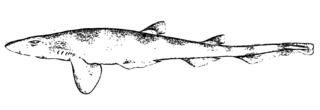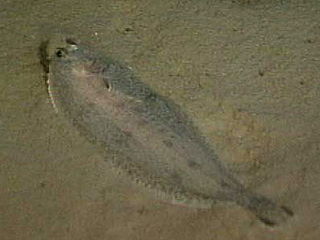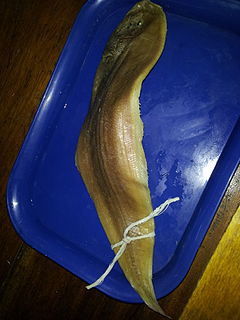
The Antilles catshark is a common but little-known species of catshark, part of the family Scyliorhinidae. It is found on or near the bottom at a depth of 293–695 m (961–2,280 ft) off Florida and the West Indies from Jamaica to Martinique. It was once regarded as a subspecies of the similar roughtail catshark, along with the longfin sawtail catshark. Growing to 46 cm (18 in) long, the Antilles catshark is a slender species with a marbled color pattern of dark saddles and blotches, as well as a crest of enlarge dermal denticles along the front part of its dorsal caudal fin margin. It feeds on shrimp and may have schooling habits. Reproduction is oviparous. The International Union for Conservation of Nature (IUCN) does not have enough data to assess the conservation status of this species.

The longfin sawtail catshark is a rare, little-known species of catshark, part of the family Scyliorhinidae. Once thought to be a subspecies of the roughtail catshark along with the Antilles catshark, it inhabits deep water off the Caribbean coasts of Panama and Colombia. This slim-bodied species has a marbled dorsal color pattern and a prominent crest of enlarged dermal denticles along the dorsal edge of its caudal fin. It can be distinguished from similar species by its relatively longer anal fin and small adult length of under 35 cm (14 in). The longfin sawtail catshark is oviparous. The International Union for Conservation of Nature (IUCN) currently lacks the data to assess its conservation status.

Glyptocephalus cynoglossus, known in English by a variety of common names including the witch, witch flounder, pole flounder, craig fluke, Torbay sole and grey sole, is a species of flatfish from the family Pleuronectidae. It occurs on both sides of the North Atlantic Ocean on muddy sea beds in quite deep water. In northern Europe it has some importance in fisheries as a food fish.
Entomacrodus cadenati is a species of fish in the family Blenniidae.

Cynoglossus is a genus of fish in the family Cynoglossidae. Most species are indigenous to the Indo-Pacific region, but there are also a few in warmer parts of the East Atlantic. They are commonly found in shallow waters on a muddy or sandy bottom, including estuaries and a few species are restricted to fresh water. One species Cynoglossus sinusarabici has invaded the Mediterranean Sea through the Suez Canal from the Red Sea, a process known as Lessepsian or Erythrean migration.
Cynoglossus acaudatus, commonly known as the Natal tongue fish is a species of tonguefish. It is commonly found in shallow muddy or sandy waters along the coast of the Western Indian Ocean, Somalia down to South Africa, including Seychelles.
Cynoglossus acutirostris, commonly known as the Sharpnose tongue sole is a species of tonguefish. It is commonly found in sandy waters of the western Indian Ocean, particularly the Red Sea and the Gulf of Aden.

Cynoglossus arel, commonly known as the largescale tonguesole, is a species of tonguefish. The eyed side of the fish is uniform brown, with a dark patch on the gill cover, and its blind side is white. They are harmless to humans and predominantly feed on bottom-living invertebrates.
Cynoglossus attenuatus, commonly known as the Fourline tonguesole is a species of tonguefish. It is commonly found in the western Indian Ocean off the eastern coast of Africa, from Delagoa Bay, Mozambique to Durban in South Africa.
Cynoglossus broadhursti, commonly known as the Southern tonguesole is a species of tonguefish. It is commonly found in the Indian Ocean off western and southern Australia.
Cynoglossus browni, commonly known as the Nigerian tonguesole is a species of tonguefish. It is commonly found in Eastern Atlantic Ocean off the coast of west Africa, from Senegal to Angola. It is found on soft substrates such as mud or sand between depths of 15m and 40 m. Its main food is small benthic invertebrates.

Cynoglossus canariensis, commonly known as the Canary tonguesole is a species of tonguefish. It is commonly found in the eastern Atlantic Ocean off western Africa, from Mauritania and Western Sahara south to Angola, including the Canary Islands and Cape Verde Islands. It is a demersal species found at depths of 10-300m, it has been found in brackish water, but is normally a coastal species which occurs over substrates of sand or mud. It feeds on small fish and crustaceans. This species is targeted in trawl fisheries throughout its range and in many areas, it appears to have undergone significant declines. For example, in Gabon the mixed Cynoglossus stock is considered overexploited, while in other parts of western Africa such as Mauritania the stocks of Cynoglossus had declined by over 60% in the five or six years up to 2015. The IUCN list C. canariensis as Near Threatened due to is dependence on conservation.

Cynoglossus capensis, commonly known as the Sand tonguesole is a species of tonguefish. It is commonly found in southeastern Atlantic Ocean off the south western coast of Africa from the Cunene River to the Cape of Good Hope. It is normally found at depths of no greater than 100m, but it has also been reported on the continental slope.
Cynoglossus carpenteri, commonly known as the Hooked tonguesole is a species of tonguefish. It is commonly found in the Indian Ocean.

Cynoglossus cynoglossus, commonly known as the Bengal tonguesole, sometines called the Gangetic tongue sole, is a species of tonguefish. It is commonly found in the Indian Ocean, particularly in brackish water and muddy or sandy bottoms off the coast of India, Bangladesh and Burma east to the Philippines.

Cynoglossus dispar, commonly known as the Roundhead tonguesole is a species of tonguefish. It is commonly found in the Indian Ocean, particularly off the coast of India, and Pakistan.
Cynoglossus dubius, commonly known as the Carrot tonguesole is a species of tonguefish. It is commonly found in the Indian Ocean off the coast of India.

Cynoglossus feldmanni, commonly known as the River tonguesole is a species of tonguefish. It is commonly found in Thailand, Laos, Borneo, Sumatra and Cambodia. It occurs in rivers in freshwater well above the tidal zone where it lives on the bottom feeding on benthic invertebrates.
Cynoglossus gilchristi, commonly known as the ripplefin tongue sole is a species of tonguefish. It is commonly found in the western Indian Ocean off Delagoa Bay, Mozambique, South Africa, and Madagascar.
Enteromius cadenati is a species of ray-finned fish in the genus Enteromius which is endemic to the Konkouré basin in Guinea.












